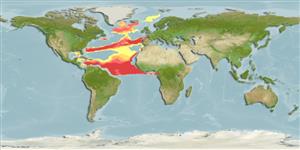>
Lophiiformes (Anglerfishes) >
Gigantactinidae (Whipnose anglers)
Etymology: Gigantactis: Greek, 'gigas' or 'gigantos' = gigantic + Greek, 'aktis' = ray (referring to the unusually long first dorsal-fin spine that functions as a lure in this genus) (Ref. 86949).
More on author: Regan.
Environment: milieu / climate zone / depth range / distribution range
البيئة
بحري مياه عميقة; نطاق العمق 2000 - 2500 m (Ref. 86949). Deep-water
Atlantic Ocean: in tropical waters.
الحجم / وزن / العمر
Maturity: Lm ? range ? - ? cm
Max length : 10.7 cm TL ذكر/ مختلط الجنس; (Ref. 44404)
وصف مختصر
الوصف الخارجي | قياسات المظهر الخارجي
الأشعة الظهرية الناعمة (المجموع): 5-6; أشعه شرجية لينه: 5 - 6. Metamorphosed females distinguished by the following characteristics: length of illicium less than 120% SL (104-107%SL); escal bulb with an elongate darkly pigmented spinulose distal prolongation; presence of short distal and slender proximal escal filaments; absence of distally flattened escal papillae; illicium without posterior pair of papillae; dentary teeth in posterior part of jaw in three longitudinal series; rays of caudal fin less than 30% SL (Ref. 86949).
Life cycle and mating behavior
النضج | التكاثر | وضع البيض | بيض | الخصوبة | Larvae
Bertelsen, E., 1990. Gigantactinidae. p. 513-515. In J. C. Quero, J. C. Hureau, C. Karrer, A. Post and L. Saldanha (eds.) Check-list of the fishes of the eastern tropical Atlantic (CLOFETA). JNICT, Lisbon; SEI, Paris; and UNESCO, Paris. Vol. 1. (Ref. 10761)
IUCN Red List Status (Ref. 130435)
استخدامات بشرية
مزيد من المعلومات
الأسماء الشائعةمرادفاتالأيضمفتريساتعلم السميات البيئيةالتكاثرالنضجوضع البيضتجمعات وضع البيضالخصوبةبيضتطور البيضة
العمر/ الحجمنموالطول-الوزنالطول-الطولالطول- التردداتقياسات المظهر الخارجيالوصف الخارجيLarvaeحركة انتقال اليرقاتتوظيفالوفرةBRUVS
مراجعالأستزراع المائيملف الأستزراع المائيسلالاتجينيElectrophoresesالتوريثالأمراضمعالجةNutrientsMass conversion
المتعاونينصورStamps, Coins Misc.اصواتالتسمم باكل السمكسرعةنوع السباحةمنطقة الخياشيمعظمة الأذندماغرؤية
أدوات
تقارير خاصة
Download XML
مصادر علي الأنترنت
Estimates based on models
Preferred temperature (Ref.
123201): 3.2 - 4.2, mean 3.6 °C (based on 93 cells).
Phylogenetic diversity index (Ref.
82804): PD
50 = 0.5000 [Uniqueness, from 0.5 = low to 2.0 = high].
Bayesian length-weight: a=0.01000 (0.00244 - 0.04107), b=3.04 (2.81 - 3.27), in cm total length, based on all LWR estimates for this body shape (Ref.
93245).
مستوى غذائي (Ref.
69278): 3.7 ±0.6 se; based on size and trophs of closest relatives
Fishing Vulnerability (Ref.
59153): Low vulnerability (10 of 100).
